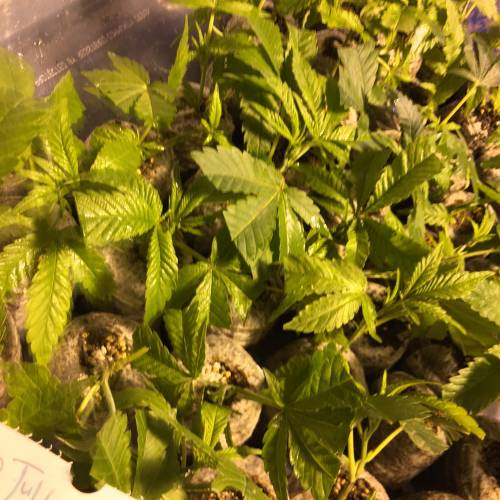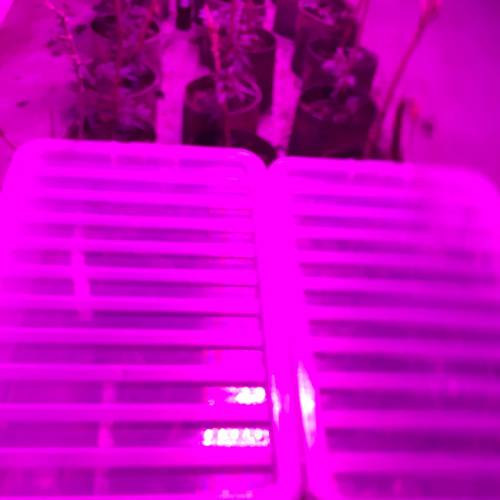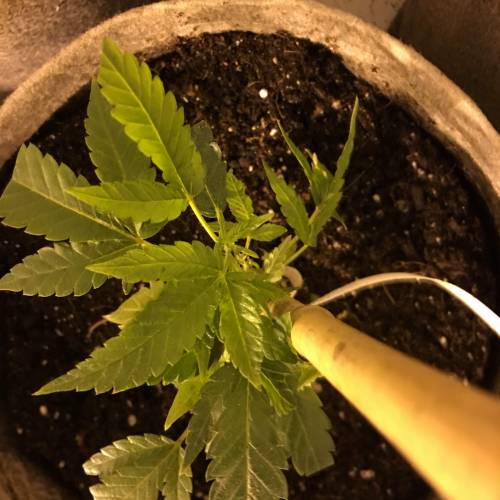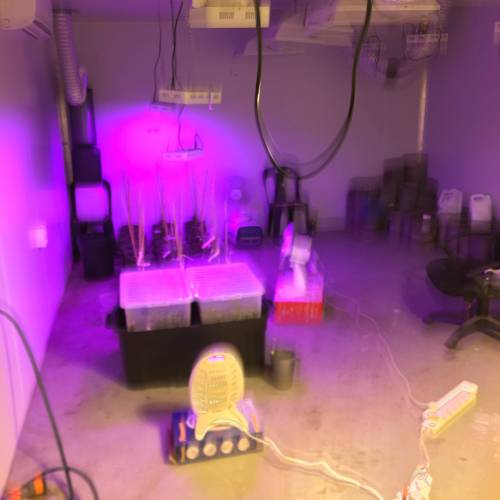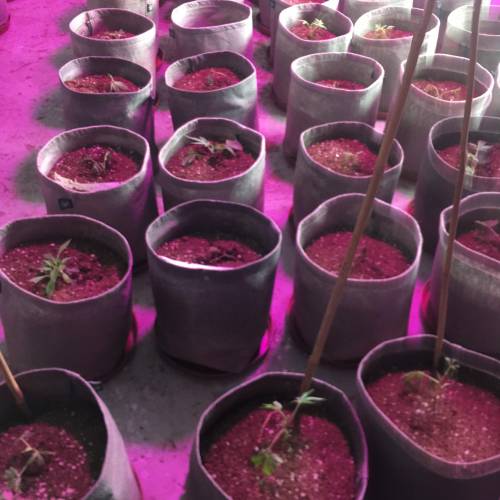The Grow Awards 2026 🏆 


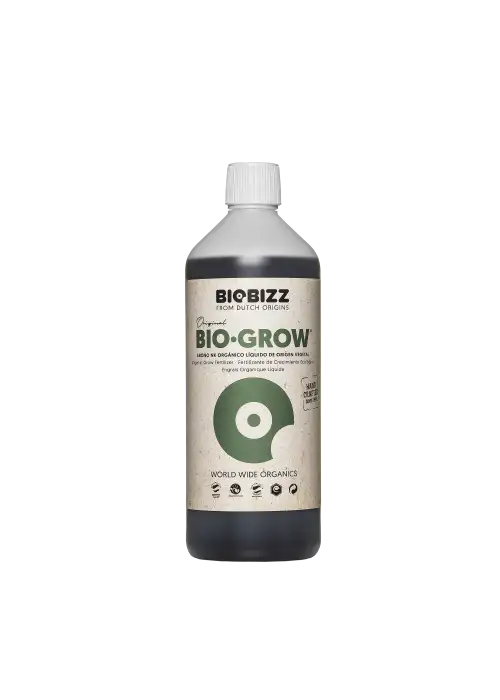




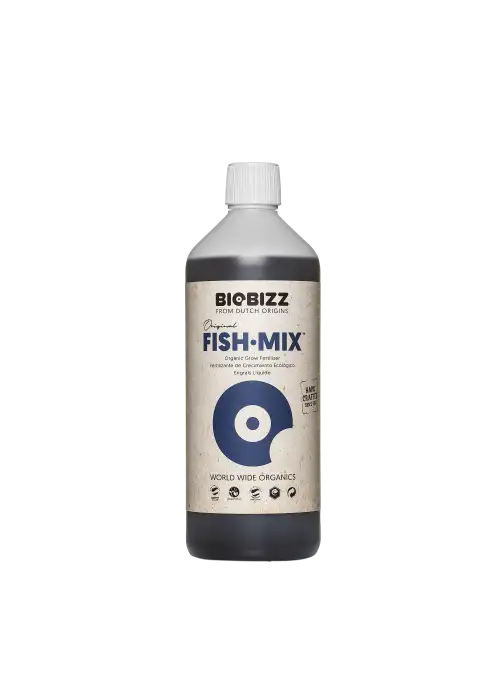

Grow1/ #BigBud / WhiteWidow / TrainWreck

VEG
Fission 300W Light Emitting Diodes/6000W
Custom

FLO
Fission 300W High-Intensity Discharge/5000W
Custom
Indoor
Room Type
LST
weeks Technique
HST
weeks Technique
Topping
weeks Technique
10 liters
Pot Size
Start at 12 Week
1
Week 1. Vegetation7y ago
3 cm
Height
18 hrs
Light Schedule
19 °C
Day Air Temp
7.0
pH
Weak
Smell
83 %
Air Humidity
16 °C
Solution Temp
16 °C
Substrate Temp
18 °C
Night Air Temp
10 liters
Pot Size
1 liters
Watering Volume
100 cm
Lamp Distance
Nutrients 1

Bio-Grow
4 mll
GreenKing Clones r 2weeks old
Mission: to make clones and flower as much plants I can
Objective in the 1st weeks r
To maintain a clean. Room with out pest
I have observe this xclones : They came with spiderMites! SO I have treat them and the whole room.
Keep plants alive And inforce healthy fast grow
I’m using soilles mixture in 10l fabric bags
I’m using a mixture of LID and LED lights
BioBizZ products,Mollasses,BatGuanna,Honey,WormJuice ,specail teaBlends.
2 likes
comments
Share
2
Week 2. Vegetation7y ago
3 cm
Height
18 hrs
Light Schedule
19 °C
Day Air Temp
7.0
pH
Weak
Smell
83 %
Air Humidity
16 °C
Solution Temp
16 °C
Substrate Temp
18 °C
Night Air Temp
3.79 liters
Pot Size
100 cm
Lamp Distance
Nutrients 1

Bio-Grow
4 mll
GreenKing Growth r seems to be slow because of winter season in Cpt.
Room r check 2/3 times per week
RoomSize 10x15
2 carbon filter extractors( u feel suction)
2x600w led r ON
1 air fan inside
Boi Grow nutri
Bio Grow+BoiBizz fish mix 2500ml -(only 2x600watt led r on atm) water 1once per week atm-
Making sum mixes to spray plant contest like tea,honey,molasses,enegery guaranna berry mix,worm casting ect
1 like
comments
Share
3
Week 3. Vegetation7y ago
3 cm
Height
18 hrs
Light Schedule
19 °C
Day Air Temp
6.6
pH
Weak
Smell
83 %
Air Humidity
16 °C
Solution Temp
16 °C
Substrate Temp
18 °C
Night Air Temp
10 liters
Pot Size
1 liters
Watering Volume
100 cm
Lamp Distance
Nutrients 1

Bio-Grow
4 mll
GreenKing Problem we’re the room is too cold ...so
Turn up 1 more 600w and turnoff extractors
The room seems still very cold just went up with 1dec
Turn on 1 Aircon/2 to 26dec (fixed problems but using more power now
As soon as I did this growth almost double in 1 week
Plants were transplanted 1 June 2018
Today it’s 22 June 2018
1 like
comments
Share
4
Week 4. Vegetation7y ago
4 cm
Height
18 hrs
Light Schedule
19 °C
Day Air Temp
7.0
pH
Weak
Smell
75 %
Air Humidity
16 °C
Solution Temp
16 °C
Substrate Temp
18 °C
Night Air Temp
3.79 liters
Pot Size
100 cm
Lamp Distance
Nutrients 1

Bio-Grow
4 mll
GreenKing Problem we’re the room is too cold ...so
Turn up 1 more 600w and turnoff extractors
The room seems now a bit more humid and stuffy plants r loving it!!!
Turn on 1 Aircon/2 to 26dec (fixed problems but using more power now so turn off to add a heater.
Every 3 days wen I check the room I turn the extractor fans on safes half the power
3 x600 watt Led (29 plants) use -10 units per day for room
From
26 July
Power units 386 on board
75/71 humidity
18/18 Dec
Turn on aircon again
Soil ph7
Plants don’t use lotta water(Secound mix 5000ml)
I give
em water as I choose my mixer that I spray i will reveal in week to week
27 June 2017
Humity is up (growth look good )
9 units power used since yesterday
83/79 humidity
19/18 Dec - i need to make it warm more with
28 June 2017
Room feel humid plants love it
I give them I good water they seem real happy the next day
372 units (/ yest 377)”””””””5 units used only on 3x600watLed( aircon off)
19 /19 Dec / 3 x600watt only on/Spray leafs with very little water
1 july they 1Mounth old
1 like
2 comments
Share
5
Week 5. Vegetation7y ago
4 cm
Height
24 hrs
Light Schedule
19 °C
Day Air Temp
6.5
pH
Weak
Smell
80 %
Air Humidity
16 °C
Solution Temp
16 °C
Substrate Temp
18 °C
Night Air Temp
10 liters
Pot Size
2 liters
Watering Volume
100 cm
Lamp Distance
Nutrients 4
Spray bottle
1 mll
Vermi Pure
1 mll

Bio-Grow
4 mll
GreenKing Week5
Plants Need Tea, Too!Dont forgive to give her :))
Plants Need Tea, Too!
I have been giving em in a spray bottle, a good mixture of tea,rooibos ,vinnala ect( help me achieve plants with burst unique flavournoids ...also the plants response of been AmaZing.🌿
My base Product :flag-ru:BioBizZ
Bio Bizz Products are a real Winner(inmyOpinion) and guarantee dank buds I have 1st hand experience that why I use it.
Most people don’t like the smell wen it stand Mix for a day or 2 but in real fact it’s it will introduce a higher count of good bacteria to your plant’s soil wen u feed.
I will start soon to infuse more living bacteria (witch are important for healthy plants with big buds)by giving Em
Worm Juice 🇿🇦. (Suplied by Wurmbosch)
From today we Added WormJuice to the BioBizZ Fish-Mix and BioBizZ Bio-Grow
Week5
2July 2018
Power 350( it’s important for me to know how much power I used)
88high/ 83low humidity :-plants love it I can see how much new light healthy green leaf coming out
19h/ 18low -: I need to make the room warm wen I make clones of this plants.!(add a heather)
3July 2018
Air extractor on for 15min( I must put a Timer on)
339 units ( 6 used )
90/90 humidity /
18h/18low Celsius
Ph7 soil ( from nex week I list the ph ofWater with added WormJuice)
Plants look healthy and growing but I wanna make em grow faster .-/will add sum MycroRoot to the coco
30 plants must be cloned to as Much I can
Next week.(Week6)
From Ther we Veg again and then it’s flowing time.
Grow need to be done end October2018.
4 July 2018
Aired out room for a 30min
330.97 Power units
81/low 79 humidity
18 / 17dec Celsius
The room feels humid the plants are loving
It ,
The soil ph 7
I added more Fish and grow and made all plant nice and Wet.
Did sum room cleaning Maintenance added Organic pest control to sprays against wall and all plants.
Switch Lights to 24 hours(3*x 600w*Led)
Floor fan is On.
👣*Notes #
What is Ph
MWhen you get down to it, growing marijuana can be a complicated process. There are so many variables to consider! Maintaining appropriate pH is one skill that even casual growers will want to have. The right pH levels will enable your plant to consume the key nutrients it needs, thrive, and produce a quality crop. And hey, tasty marijuana is definitely a good reason to get a little nerdy about your soil.
In chemistry, pH is a numerical scale used to test the acidity or alkalinity of a given substance. The scale ranges from numbers 1 through 14. The lower the number, the more acidic. The higher the number, the more alkaline. A pH of 7 is neutral.
Hydrogen is what is actually being measured by the pH scale. In fact, pH stands for “power of hydrogen”. Acidic substances contain more hydrogen while alkaline substances contain more hydroxide.
In order to grow great buds, your plants need to absorb the nutrients properly. To do that, your soil or hydroponic solution need to be at the correct pH. The optimal pH for cannabis is about 6. Though, the plant can tolerate a pH between 5.8 and 6.5. Yet, if you’re looking for the best results, you’ll want to keep it as close to 6 as you can. When kept at this pH, the plant is better able to suck up nutrients through its roots.
7. Plant-beneficial soil microbiology is drastically hindered when pH levels are too high or too low. Useful fungi, for example, prefer a slightly acidic pH between 2 and 7. Bacteria prefer more alkaline environments between 5 and 9.
If you’ve planted in a high-quality soil and your plant is showing signs of nutrient deficiency, pH might be to blame. Since pH is what enables your plant to take in nutrients through its roots, simply adding in more nutrients won’t do the trick if your issue is with pH. So, testing pH is very important for diagnosing issues with your plants.
Adding excess salt to your soil causes the pH to be more alkaline. If you want to avoid upping the pH level of your soil, stay away from products that contain sodium. Salts also dehydrates organisms that live in the soil, which decreases soil health. This, in turn, takes vital nutrients away from your plants
Weed love a fairly acidic soil and lots of fungus. While marijuana thrives in soil that’s slightly acidic, the herb doesn’t require as low of a pH as a fir tree does. It also prefers more bacteria in the soil than what you’d find out in the woods. So, investing in some high-quality potting soil with the right pH is a must.
Avoid fertilizers that contain sulfur and ammonium. Synthetic fertilizers and other chemical additives also have a drastic impact on soil microbiology. When you decrease the soil microbiology, you decrease the amount of nutrients and trace elements available to your plant. This can significantly impact plant health.
1 like
2 comments
Share
6
Week 6. Vegetation7y ago
5 cm
Height
24 hrs
Light Schedule
22 °C
Day Air Temp
6.4
pH
Weak
Smell
1900 PPM
TDS
94 %
Air Humidity
16 °C
Solution Temp
20 °C
Substrate Temp
22 °C
Night Air Temp
10 liters
Pot Size
0.5 liters
Watering Volume
115 cm
Lamp Distance
Nutrients 3
Spray bottle/
1 mll
Vermi Pure
8 mll
MYcroRoot
6 mll
GreenKing Week 6 -From the beginning. 🌱
15 July Sunday 2018 :3Am(63 hours since last check up)
Room feel humid and mildly hot plants r finding it in favor.
- [x] Humidity were @ high of 91 low of 75
- [x] Temp were @ 21
- [x] Power were @ 225=(in 63 hours since we been here last we used 37units)
3x600 watt(all 3 use about 7/8 unit a day)
1x400 watt heater(used 4/5 units a day)
🌱Clones (2 containers-186 clones)28dec
- [x] 80/90 percent looks healthy and upwards
- [x] Humidity is 100percent
Very wet area with added WormJuice
- [x] I made a solution of hormone power and sprayed on clones on 30plants
- [x] About 5/6 leafs were turning I cut it out
🌱The 30 plants r showing growth we continue to treat the soil
- [x] 5000ml water (20dec)+ Hormone Power ph 6.4 / ppm 1900- give very little to each plant
Week 6 - CLoNinG Week🌱
Thursday 12 July (23pm)
Room feels mildly hot but humid
- [x] 91/90 humidity
- [x] 21 Dec high
- [x] heater on1 bar on timer
- [x] I switch of the fans
- [x] 260 Power on the dot (23units for 2 days used
Clones *150currently 🌱Today we added 38 more 🌱*183 clones
- [x] Spray them with mineral water
- [x] All the clones r Alive and growing upwards
- [x] Humidity 100 percent
- [x] Very wet Area
- [x] Fan blowing heat help for me
- [x] Added *38 more clones today
The 🌱30 plants r now all on the same level as little plants I want to get the soil a bit dry
11July2018
I made 50 more clones (1trainwreck +49 bigbud
Added 1fan /2 on NOW
Added a heater
Added new sticks ALL on 1size
Humidity is 94
25 is the temp
Sweep room clean.
10 July 2018 #Week6🍃Tue
Made 100 clones (22 TrainWreck/20WhiteWidow/58 Big Bud)
I will Monitor them 2c SuccessRate
Room felt humid but not hot@ 94/87
22dec Celsius
I Aired out the room 6hours
288 units wen I left 283( used 1000w for 6hours)
I Added WormJuice with the ClonePellets
Switch off fan /
3x600watt LED r on 24hours.
I will B able to make a few more clones Tomm.
9July Week6🌱
21 Dec Celsius
91/88 humidity
298.13( used 24.11 in 3days)
I added more buckets of water to push humidity up
Give plants little/lite Mix/water +10l WormJuice
6July Fry 2018 Week5
19/18celsuis( because of the adds water temp rise over the next days
88/86 humid ., plant love it
322.24 Power
Added water buckets to Room
Snip leafs to encourage more growth
Give em a bit MycroRoot a pinch
Give 20l water mix with Worm juice.
🕊️
Notes*🐾I’m trying to keep my soilless mix in tipTop shape to increase the microbes in the soil for rapid healthy growth here is sum notes on Microbes
Bacteria
Healthy soil is a rich, living environment with millions of busy microbes competing for available water, food and space. Sometimes the microbes eat each other and sometimes they get along just fine. Either way, it’s difficult to grow a viable crop without an active population of microscopic soil dwellers.
Microbes, consisting primarily of bacteria, fungi and a few other tiny organisms, are often thought of as invaders that pose a threat to crops, animal and people. While it’s true that some microbes are bad, most are essential elements of a healthy growing environment.
Here is a quick rundown on a few of the most common microbes found in healthy soil:
* are an amazingly diverse group of microscopic, single-celled organisms. They are plentiful and multiply rapidly. In fact, one teaspoon of healthy soil contains at least a million bacteria, and maybe up to a billion.
* Fungi
may be primitive plants, but most are the underappreciated good guys of the plant world, working hard to break down plant matter, decompose soil pollutants, discourage pests, fight pathogens and improve uptake of nutrients. A teaspoon of soil usually holds many yards of fine, multi-shaped fungal filaments.
* Algae
reside primarily on the surface and upper layer of healthy soil and produce their own food via photosynthesis. These tiny plants hold soil together and help process plant matter.
* Nematodes
are microscopic, worm-like organisms. It’s true that some are harmful, but they are greatly outnumbered by good nematodes that eat decomposing plant matter, distribute beneficial fungi and bacteria through the soil, and eat harmful root-feeding nematodes. One square foot of soil contains millions of the little guys.
* Actinomycetes
look much like fungi, but they’re actually a unique type of bacteria with a number of important roles in healthy soil, including production of natural antibiotics that detoxify soil and help fight root diseases. If your soil smells rich and earthy, you can be sure that actinomycetes are hard at work.
* Protozoa
are single-celled organisms that release critical nutrients like sulfur, phosphorus and nitrogen, thus making them more available to plants. Protozoa are also a good food source for beneficial types of nematodes. How many protozoa in a teaspoon of soil? Thousands!
Microbes work hard and tirelessly to keep soil healthy. Exactly what do those millions of amazing microbes do? For starters, here are a few of their many jobs:
* Enhance moisture availability and improve water absorption and retention, even in sandy soil.
* Increase resistance to pests and disease by suppressing harmful pathogens.
* Reduce erosion and prevent runoff.
* Prevent compaction by keeping soil loose and arable.
* Improve soil structure by decomposing organic matter.
* Retain nutrients around plant roots
I have used BioBizZ they did a fairly good job but I seek to add more oomph
Worm juice I added and it did a Amazing job;
🐾By now you’ve probably heard of 'worm juice' or 'worm tea'. But in case you’ve never heard of it, worm juice is the liquid that you collect from a worm farm. Some people also call this worm tea but hardcore worm farmers use this term to refer to a potent brew they make by adding molasses to ‘worm juice’ and aerating it with an aquarium pump to increase the numbers of beneficial microbes in the liquid fertiliser that this process creates. The short story is, whether you make ‘worm juice’ or brew up a pot of ‘worm tea’, it can be used as a fertiliser for your garden, and here are some reasons why it’s actually amazing.
It’s the Best Fertiliser you can use (Natural or Otherwise), and it’s free
Worm Juice, also known as ‘liquid gold’, is a magical elixir that provides billions of good microbes such as fungi, and helpful, nitrogen-fixing bacteria to your plants and veggies. You don’t see these good microbes in synthetic liquid fertilisers, so nothing beats this recipe from mother nature. If you use your kitchen scraps to feed your worms you are returning all those extra nutrients into your soil in exactly the right balance as you are harvesting. Win, win, win!
Every time someone uses worm juice they’ve never seen their vegetables get so big. It is the secret of those giant pumpkin competitions, adding extra inches to those 200 kg heavyweights.That’s because worm juice is a liquid supplement for plants. Similarly, by introducing a higher count of good bacteria to your plant’s soil, beneficial microbial activity is immediately kickstarted. Organic matter is broken down more rapidly, helping build good soil structure that increases vital soil aeration, moisture and nutrient absorption and storage, healthier soil and ultimately boosts your harvest of organically grown veggies!
It’s a Natural Insect Repellant
As if that wasn’t enough, worm tea also acts as a natural insect repellant. The tea contains microorganisms which produce chitanase, a digestive enzyme that breaks down the exoskeletons of insects such as arthropods. Additionally, the microbes have disease suppressant qualities too, helping to stop problems such as root rot! Simply spray the worm tea on the leaves of your plants until it is dripping onto and into the soil to give protection from various root and foliar pathogens, as well as the pesky insect pests.
Values of WormJuice
* Nitrogen – 1120 ppm: That’s high for a fertilizer. About twice the concentration I’d use if I were applying a liquid fertilizer to my plants at home. The nitrogen is present mostly as nitrate, which is a good thing. If the nitrogen were present primarily as ammonium, that might cause problems.
* Phosphorus – 22 ppm: That’s a good/appropriate concentration of phosphorus for most plants. It’s much less than we apply when we use a typical garden fertilizer. Potassium – 5034 ppm: This is an order of magnitude higher than we’d apply for most plants using a liquid fertilizer.
* Calcium – 279 ppm: This is a reasonable amount of calcium.
* Magnesium – 211 ppm: This is reasonable amount of magnesium.
* Sodium – 634 ppm: I’d like to see less sodium, but this shouldn’t cause a major problem.
* Other elements present included Iron, Copper, Manganese, Zinc, Molybdenum, and Boron, all at levels less than 1 ppm.
FromWeek7 I will start to use BlackStrap Molasses to feed the Soil. InWeek8 I’m gonna add More Sweetness.
likes
comments
Share
7
Week 7. Vegetation7y ago
5 cm
Height
24 hrs
Light Schedule
26 °C
Day Air Temp
6.4
pH
Weak
Smell
100 PPM
TDS
75 %
Air Humidity
20 °C
Solution Temp
20 °C
Substrate Temp
21 °C
Night Air Temp
10 liters
Pot Size
0.3 liters
Watering Volume
115 cm
Lamp Distance
GreenKing Fryday 20 July 1 am
- [x] 140 Power
- [x] I switch fans off air flow off/
- [x] 72/62 humity/
- [x] 21/23 temp
- [x] A few clones look weak
- [x] Room feels hot and humid
- [x] I give a bit clean water to plants
likes
comments
Share
8
Week 8. Vegetation7y ago
3 cm
Height
24 hrs
Light Schedule
26 °C
Day Air Temp
6.4
pH
Weak
Smell
100 PPM
TDS
75 %
Air Humidity
20 °C
Solution Temp
20 °C
Substrate Temp
21 °C
Night Air Temp
10 liters
Pot Size
1 liters
Watering Volume
115 cm
Lamp Distance
Nutrients 1
Pure water
20 mll
GreenKing Tue/Wens 11 pm24 July Week7 Clones Are Ready
- [x] Power 61.23 /
- [x] 78/76 humidity
- [x] 28/25 are the temp room feels hot I have not been here in
- [x] 120 -/out of 186 rooted ( sum look weak and I just chuck em out we have a time limit)
I left 25july 4am wens
Tired will continue Tomm nite
- [x] Room temp were at 22 wen I left
- [x] Power at59
- [x] I give little clean water to all plants
4 likes
5 comments
Share
9
Week 9. Vegetation7y ago
5 cm
Height
18 hrs
Light Schedule
28 °C
Day Air Temp
7.0
pH
Strong
Smell
100 PPM
TDS
89 %
Air Humidity
18 °C
Solution Temp
20 °C
Substrate Temp
20 °C
Night Air Temp
10 liters
Pot Size
1.5 liters
Watering Volume
80 cm
Lamp Distance
Nutrients 2
MYcroRoot
0.586 mll
Pure water
20 mll
GreenKing Week 9
[ ] Give little amount clean water
- [ ] 89/75 humidity room feel like it’s getting very humid
- [ ] Room we’re at a high of 22dec Celsius
- [ ] I switch of the heater and the fans just to safe sum power(strap for cash)
- [ ] Power units are at 55.
- [ ] Cleaned room.
- [ ] 120+>~ Clones - 🌱
1 like
comments
Share
10
Week 10. Vegetation7y ago
6 cm
Height
18 hrs
Light Schedule
28 °C
Day Air Temp
7.5
pH
Weak
Smell
100 PPM
TDS
99 %
Air Humidity
18 °C
Solution Temp
20 °C
Substrate Temp
20 °C
Night Air Temp
10 liters
Pot Size
1.5 liters
Watering Volume
80 cm
Lamp Distance
Nutrients 1
Pure water
20 mll
GreenKing Room Strarting to feel very HUMID
I decided to SELL 100 well rooted healthy plants.
Week 10 / 30 July 🌱 Cash flow is a problem/
- [ ] Give little amount clean water again
- [ ] 99/99 clones were loving the high humidity but I have to maintain this high humidity
- [ ] Room we’re at a high of 23 Celsius low 21
- [ ] Power units are at 14 units
- [ ] Room is very wet
- [ ] 120+>~ Clones - 🌱 must be sold as soon as possible.
1 like
comments
Share
11
Week 11. Vegetation7y ago
7 cm
Height
18 hrs
Light Schedule
22 °C
Day Air Temp
7.3
pH
Weak
Smell
99 %
Air Humidity
18 °C
Solution Temp
17 °C
Substrate Temp
20 °C
Night Air Temp
10 liters
Pot Size
1.5 liters
Watering Volume
100 cm
Lamp Distance
Nutrients 1
Pure water
20 mll
GreenKing Week 11 / 1-10August/ 🌱 100clones will sell
- [ ] 20l give little clean water again for 3weeks now( previously I give a high amount of nutrition)
- [ ] 99/99 humid
- [ ] Room we’re at a high of 23 Celsius low 21
- [ ] Power units are at 1612 I bought 5000rand
- [ ] Rent Paid 6500r
- [ ] Room is very wet
- [ ] 100 Clones - 🌱 sold for 26000rand(1823 dollar) @ 1 for 260r(18/19dollar)
1 like
comments
Share
12
Week 12. Vegetation7y ago
8 cm
Height
24 hrs
Light Schedule
25 °C
Day Air Temp
7.0
pH
Weak
Smell
450 PPM
TDS
75 %
Air Humidity
18 °C
Solution Temp
17 °C
Substrate Temp
20 °C
Night Air Temp
10 liters
Pot Size
1.5 liters
Watering Volume
100 cm
Lamp Distance
Nutrients 2

Fish-Mix
3 mll

Bio-Grow
3 mll
GreenKing 🌱Week 12 August 2018 - Winter
I been so busy lately had limit time at Growing
Hudmudity is down down @75
- [ ] 20l-30 With BioGrow+fish Mix 3ml give em
- [ ] Feel feels easy breathable in room ,plant are doing good can be better
- [ ] Room we’re at a high of 25 Celsius low 20
- [ ] Power units are at 1357
- [ ] Room floor is nice and dry and plants only wet at the bottom
- [ ] I workt Thru all the plants soilless mixture and
- [ ] 100 Clones nd 3 big plant - 🌱 sold for now I have a few more clones left and most of the big plants
2 x 600watt led and 1x1000 watt light are on + 2 floor fans and 1 heater /extractor on timer
1 like
comments
Share
Enjoying this diary? Follow for more updates!
Prefer the old Diary view?
Go back to the old Diary view





























































